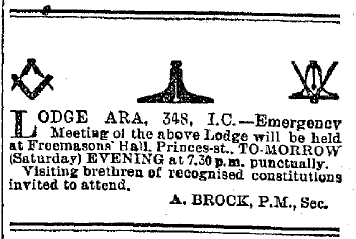An inside view of Freemasonry from Auckland’s United Masters Lodge No. 167
The history of freemasonry in New
Zealand goes back to the 1830’s and includes members such as Sir George Grey, former
Prime Minister William Ferguson Massey, Sir Peter Buck and Sir Mason
Durie. Now 100 years of local and international Masonic history is
available to view on a CD-ROM containing Auckland’s United Masters Lodge No.
167 Transactions periodical, 1909-2009,
revealing a detailed picture of Freemasons’ ethics, ceremonies and symbols.
Several items document early
Freemasons activities in Auckland including the first recorded meeting at which
members were present - the laying of the foundation stone of St Paul’s Anglican
Church, then in Emily Place, in 1841.
The first Lodge in Auckland to build its own meeting place, Ara Lodge, held their meetings in the Exchange Motel, Shortland Street, before moving in February 1844 to the Royal Hotel, where the Northern Club now stands. In 1845 they decided to build their own premises and bought a £150 section in Princes Street, building the Masonic Hotel. This was let to a hotelier - with one room being exclusively reserved for Lodge meetings.
However, the first Masonic hall was built by Eden Lodge –
who began meeting at Karangahape Road’s Rising Sun Hotel. The Eden brethren bought
a section on Karangahape Road and built a 40' x 25' temple, with a heavily
moulded ceiling. Members
had great difficulties travelling to meetings at that time. “Some of the
brethren were farming at Epsom and that involved a journey by horse of at least
four miles, with a corresponding effort of unsaddling, feeding and stabling at
the journey’s end.” Consecrated
in 1879, this building was still standing in 1958, partly used as a milk bar,
and partly as a bank – and the ceiling was still recognisable.
The CD-ROM includes papers about
the early history of Freemasonry on the North Shore, too, recording in the
early days, “difficulty was sometimes experienced in finding sufficient members
formally to open the Lodge. It did happen that on more than one occasion a
Brother was brought in from the streets wearing informal clothes and carpet
slippers so that the proceedings could be opened in due form.”
A 1972 paper investigated Maori
Freemasons providing brief biographical details of many men who were high
achievers in all sectors of society from banking to police, arts to politics.
A 1948 paper details reasons for
and against the inclusion of women as Freemasons with viewpoints stretching
back to the secret societies of Ancient Egypt. In 2004, in the Question and
Answer section of Transactions, a
member asked why the regulations forbade the admission of women as members and
the answer was that historically some guilds did admit women, “usually the wife
or daughter of a member or a deceased member. Bakers did and so did dyers,
though for reasons of decency the dyers prohibited men and women treading in
the same vat.”
In the early decades of last century Herman Schmidt took some wonderful portraits of men in full Freemasons' regalia like the one below. To browse these images go to Heritage Images and search 'masons'.
Author: Leanne, Central Auckland Research Centre







Comments
Post a Comment
Kia ora! Please leave your comment below.